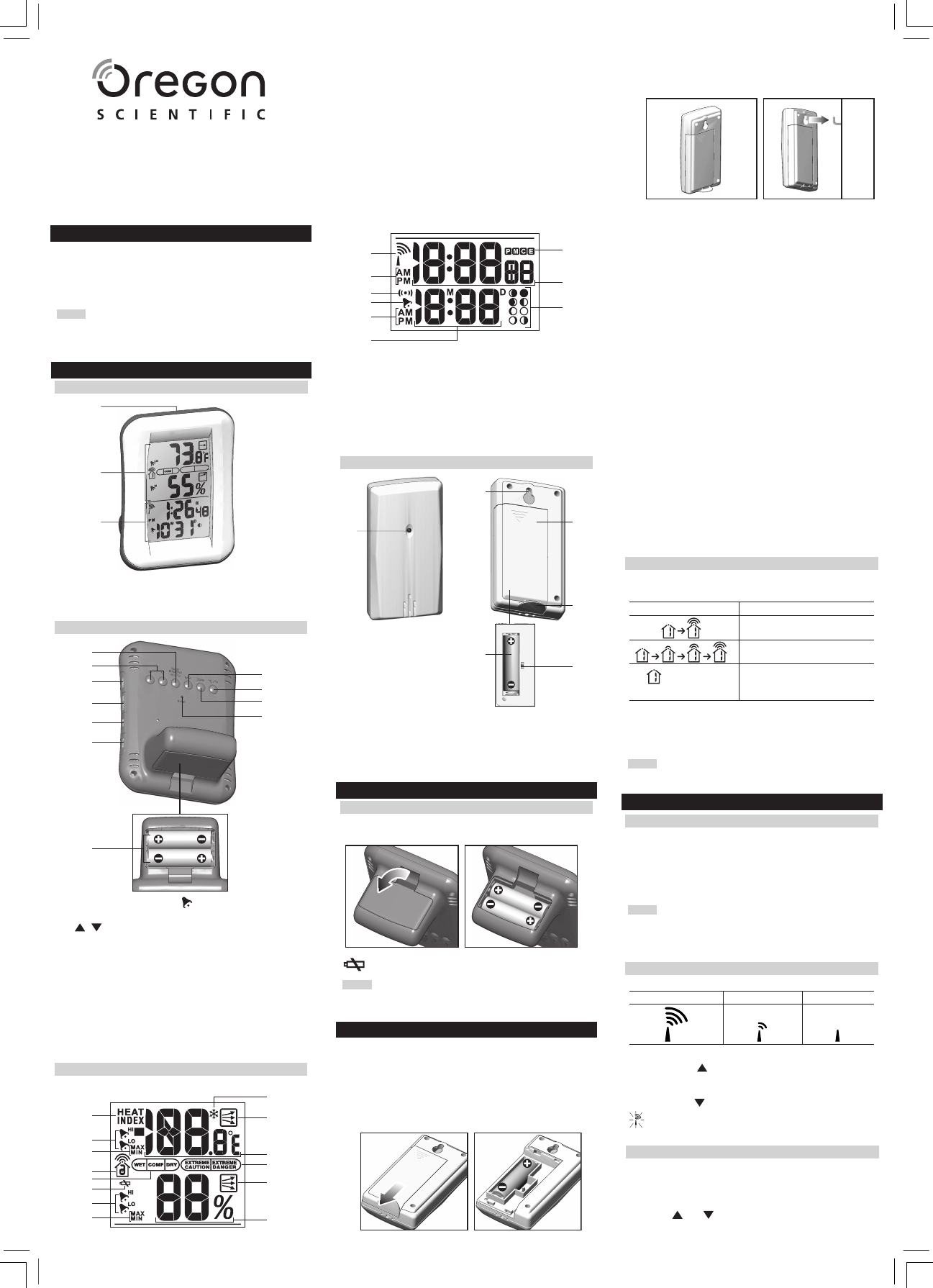
INTRODUCTION
Thank you for selecting this Oregon Scientic
TM
Wireless
Indoor / Outdoor Thermometer with Indoor Humidity and
Self-Setting Atomic clock (RMR683HGA). This clock is
supplied with a remote sensor (THN132N) and can support up
to 3 sensors in total (additional sensors sold separately).
NOTE Please keep this manual handy as you use your new
product. It contains practical step-by-step instructions, as well
as technical specications and warnings you should know
about.
CLOCK OVERVIEW
FRONT VIEW
1. SNOOZE
2. Temperature and Humidity Area
3. Clock / Alarm Area
BACK VIEW
1. TEMP / HUMIDITY HI / LO : Change settings or enable
/ disable hi or lo temperature / humidity alarm
2. / : Increase / decrease setting; activate / deactivate
clock reception signal
3. CHANNEL: Switch remote sensor display
4. HEAT INDEX
5. MODE: Change settings / display
6. ALARM: View alarm status; set alarm
7. Battery compartment
8. MEM: View current, maximum and minimum temperature
/ humidity
9. °C / °F: Select temperature unit
10. ZONE: Toggle US time zone
11. RESET: Reset unit to default settings
LCD DISPLAY
Temperature and Humidity area:
1. Heat index icon
2. Hi / lo temperature alarm
3. Max / Min temperature icon
4. Sensor reception icon
5. Comfort Zone
6. Battery low icon
7. Hi / lo humidity alarm
8. Max / Min humidity icon
9. Ice warning is active
10. Temperature trend
11. Temperature
12. Heat Index Warning
13. Humidity
14. Humidity Trend
Clock / Alarm area:
1. Clock signal reception
2. AM / PM mode selected
3. Alarm mode
4. Alarm set
5. AM / PM mode selected
6. Alarm time
7. US time zone
8. Clock
9. Moon Phase
REMOTE SENSOR (THN132N)
1. LED Indicator 1. Wall mount
2. Battery compartment
3. Battery door
4. Table stand
5. CHANNEL switch
GETTING STARTED
SETTING UP THE CLOCK
Insert batteries before first use, matching the polarity
(+ and -). RESET after each battery change.
indicates main unit batteries are low.
NOTE Do not use rechargeable batteries. We recommend
that you use alkaline batteries with this product for longer
usage and lithium batteries in temperatures below freezing.
REMOTE SENSOR
The sensor collects temperature readings approx. every 40
seconds and sends them to the main unit. The main unit can
collect data from up to 3 sensors.
To set up the sensor:
1. Slide open the battery door.
2. Insert the batteries, matching the polarity (+ / -).
3. Select a channel. Make sure you use a different channel
for each sensor.
4. Close the battery compartment.
5. Secure the sensor in the desired location using the wall
mount or table stand.
For best results:
• Place the sensor out of direct sunlight and moisture.
• Do not place the sensor more than 30 m (100 ft) from the
main (indoor) unit.
• Position the sensor so that it faces the main (indoor)
unit, minimizing obstructions such as doors, walls, and
furniture.
• Place the sensor in a location with a clear view to the
sky, away from metallic or electronic objects.
• Position the sensor close to the main unit during cold
winter months as below-freezing temperatures may affect
battery performance and signal transmission.
The transmission range may vary depending on many factors.
You may need to experiment with various locations to get
the best results.
Standard Alkaline batteries contain signicant amounts of
water. Because of this they will freeze in low temperatures
of approximately -12°C (10°F). Disposable Lithium batteries
have a much lower threshold for temperature with an
estimated freezing range of below -30°C (-22°F).
Wireless ranges can be impacted by a variety of factors
such as extremely cold temperatures. Extreme cold may
temporarily reduce the effective range between the sensor
and the base station. If the unit’s performance fails due to
low temperature, the unit will resume proper functioning as
the temperature rises to within the normal temperature range
(i.e. no permanent damage will occur to the unit due to low
temperatures).
SENSOR DATA TRANSMISSION
The sensor reception icon in the temperature and humidity
area shows the status.
ICON DESCRIPTION
Main unit is searching for the
sensor(s)
A channel has been found and
sensor signal is being received
and “- - . -“ The sensor cannot be found.
(Temperature Search for the sensor or
and Humidity Area) check batteries
To search for a sensor:
Simultaneously, press and hold MEM and CHANNEL for
2 seconds.
NOTE If the sensor is still not found, check the batteries,
obstructions, and remote unit location.
CLOCK
CLOCK RECEPTION
This product is designed to synchronize its date and time
automatically once it is within range of the WWVB-60 signal
from the atomic clock in Boulder, Colorado.
The clock collects the radio signals whenever it is within 1500
km (932 miles) of a signal.
NOTE Initial reception takes 2-10 minutes for rst set up or
when RESET is pressed. Once complete, the reception icon
will stop blinking. If the signal is weak, it can take up to 24
hours to get a valid signal.
RECEPTION SIGNAL
Clock signal reception indicator:
STRONG SIGNAL WEAK SIGNAL NO SIGNAL
To enable and force a signal search:
Press and hold for 2 seconds.
To disable the signal reception:
Press and hold for 2 seconds.
ashes when it is disabled.
SET CLOCK
To manually set the clock make sure the clock signal reception
is disabled.
To manually set the clock:
1. Press and hold MODE for 2 seconds.
2. Press and to change the settings.
3. Press MODE to conrm.
Wireless Indoor / Outdoor Thermometer
with Indoor Humidity and
Self-Setting Atomic Clock
Model: RMR683HGA
USER MANUAL
�
RMR683HGA_M_OSIUSA_R6 2006.2.23, 9:22 AM1




